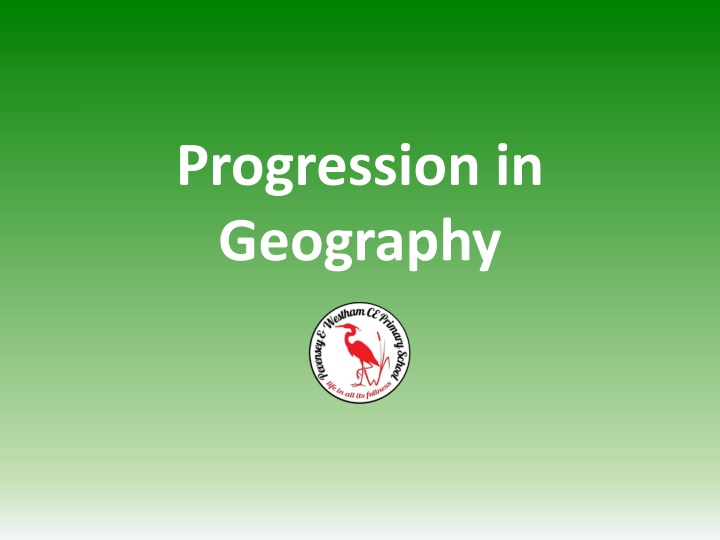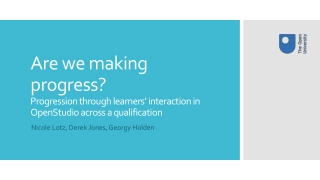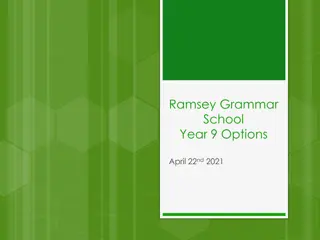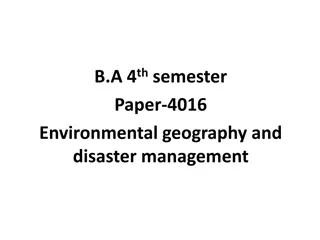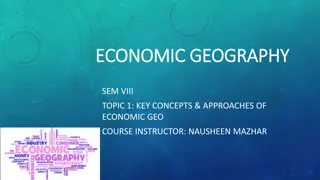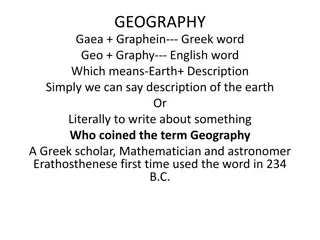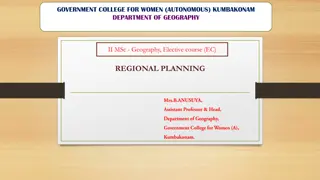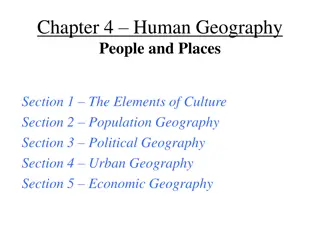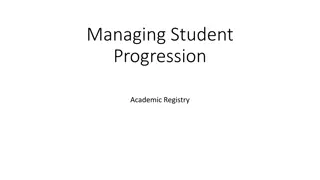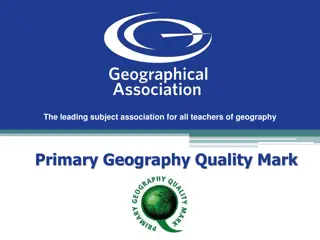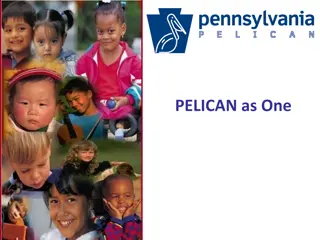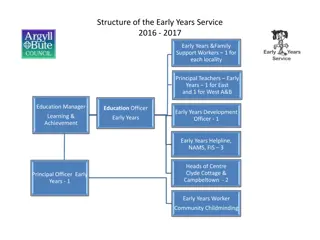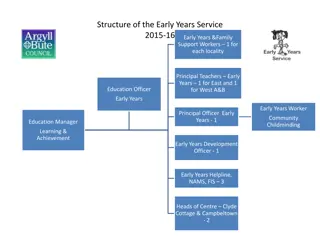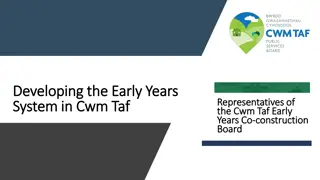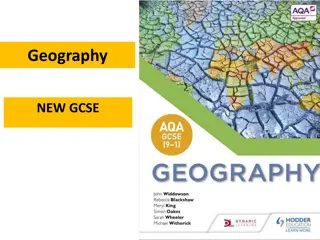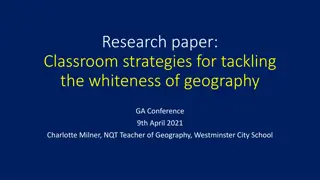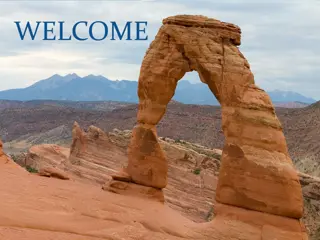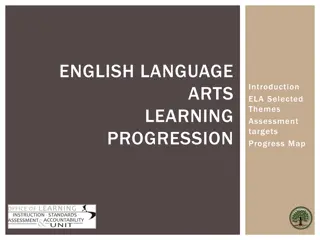Progression in Geography for Early Years Learning
Building on geography foundations in reception year through fun activities exploring local areas, countries, the universe, and more, to prepare for Year 1 curriculum. Engaging core texts and home learning links provided for continued support.
Download Presentation

Please find below an Image/Link to download the presentation.
The content on the website is provided AS IS for your information and personal use only. It may not be sold, licensed, or shared on other websites without obtaining consent from the author.If you encounter any issues during the download, it is possible that the publisher has removed the file from their server.
You are allowed to download the files provided on this website for personal or commercial use, subject to the condition that they are used lawfully. All files are the property of their respective owners.
The content on the website is provided AS IS for your information and personal use only. It may not be sold, licensed, or shared on other websites without obtaining consent from the author.
E N D
Presentation Transcript
Progression in Geography
Early Years Laying the Foundations for Geography Throughout the reception year at PAWS I will be building on the foundations in geography that will allow me to The following activities will provide opportunities to develop the required knowledge I need; Term 1 Me and my family Use a simple map to explore the school building and grounds. Explore our local village to familiarise with immediate surroundings. Create simple maps to mark significant landmarks in our community and explain what makes our village unique. Term 2 My country Explore our capital city using books, websites and online videos. Compare London to the environment of our local area recognising the similarities and differences of a village to a big city. Term 3 My country Explore countries across the globe, concentrating on any places that may be of significant interest to any members of the cohort. Recognise and address any similarities and differences between life in this and other countries, exploring manmade and natural elements and the different ways in which people live. Term 4 My universe Look at our planets place in the Solar Systema and explore the elements of the universe including the sun, moon and stars. Research what our planet looked like a long time ago compared to now and what it was like when dinosaurs ruled the world Term 5 Looking after myself and others Experience the hatching of ducklings and study our local area to find the perfect place for our ducks to live, considering suitable habitats and potential predators. Walk to our local farm and explore the farmland, considering the type of environment animals need to live. Term 6 - My next move Travel to Bushy Wood to compare the elements of a larger woodland to that of our small woodland at school. I will gain relevant experiences of geography through the continuous and enhanced provision within the following areas; Know where I live Know my journey to school Talk about some of the differences in notice when I am in a different places Large and small role play (inside and outside), all small world areas, reading, sand and water areas, music and computing areas. Talk about places when looking at books and watching tv/videos. Talking about places that I have been to Talk about places in stories Use language that relates to place By the end of the reception year, I will have gained a good level of development in the following areas, which will sufficiently prepare me for the Year 1 geography curriculum at PAWS. Recognise elements of my environment that are manmade and natural Make maps from stories Follow simple maps in play Understanding the world - The natural world - People, culture and communities
Early Years Laying the Foundations for Geography These core texts will stimulate discussion and help me to make links within my understanding; These home learning links will help my parents and care givers support my learning at home: I will widen my art vocabulary as I become exposed to and encouraged to use the following words; Environment, Place England, London, Capital city World Town, Village Castle, Beach, Post Office, Farm Weather rainy, sunny, cloudy, storm, snowy, windy, hot, cold Seasons summer, spring, autumn, winter Mountain Sea Cliff Map, Globe Exploring Directions forwards, backwards, up, down Symbols https://www.natgeokids.com/uk/teacher- category/geography/ The Everywhere Bear Martha Maps it Out The Jolly Postman A Walk in London Santa is coming to Eastbourne, We re going on a Lion Hunt The Ugly 5 Handa s surprise The Little Red Hen Makes a Pizza The Magic Paintbrush Quill Soup Chapatti Moon Anna Hibiscus Song What the Ladybird Heard Rosie s walk There s room for everyone Where does my food come from? https://www.rgs.org/schools/resources- for-schools/the-united-kingdom https://www.kids-world-travel- guide.com/ https://www.ordnancesurvey.co.uk/mapzo ne/ https://world-geography-games.com/ Spotlight on SEND Inclusive and Adaptive teaching Pupils with SEND are supported across the curriculum through Quality First Teaching informed by Inclusive and Adaptive teaching practices. This is part of our universal offer. Here are some examples of the work that we have created so far!; Hyperlink to Geography evidence folder. Subject specific inclusive and adaptive strategies can be found here.
Environment Processes Change Interdependence Sustainability Diversity Location Scale Distribution Interaction EYFS Pevensey and Westham School Geograp hy What features are found in the local area? Substantive Knowledge Discipline Knowledge End Points of Learning Pupils will know: Fieldwork data collection: Pupils making a good level of progress will: The human and natural features found around the school grounds Observe, record and interpret a journey around the school by collecting items e.g. grass, leaves, stone, litter etc. 1. Identify human and natural features found around the school grounds The difference between natural and human 2. Recognise that the school is in a village called Westham in the UK That the school is in a village called Westham in the UK Data representation: Pictogram (Journey Bucket/Stick) 3. Present a simple map to represent the school grounds or playground How to draw information from a simple map Mapwork: How to create a simple map to represent the school grounds or playground 4. Identifyand describe the main elements of the weather Aerial and Satellite photographs, Google Earth, School OS Map, 3D Maps Vocabulary and knowledge from observation, discussion, stories, non-fiction texts and maps to describe the local area 5. Describe how weather conditions change in the UK during the four seasons Thinking skills Recognise Name and point out who or what something is Important processes and changes in the natural world around them, including the seasons Distinguish something or someone from others that may be similar Identify 6. Describe how the weather is different in some countries in the hot and cold areas of the world Say what you see . Give an account in words of something or someone Describe How to make observations and recordings to describe and recall a route around the school grounds 7. Recognise the location of the Equator, North Pole and South Pole Identify and distinguish with a degree of analysis some things that may potentially be more noteworthy or important than others Observe Decide upon and choose that information considered most suitable or relevant Select To use directional language to recall a journey around the school grounds e.g. behind the tree, through the gate etc. Building on Observed and discussed how the weather changes during the day and four seasons Observed and discussed seasonal signs in the natural world Use all their senses in hands-on exploration of natural materials Begin to understand the need to respect and care for the natural environment and all living things Understand position through words alone. For example, The bag is under the table, with no pointing Describe a familiar route Discuss routes and locations, using words like in front of and behind Arrange information into particular groups according to shared qualities or characteristics Categorise/ Classify Place a set of related events or things that follow each other into an order Sequence ELG: Understanding the World Find similarities and differences Compare and contrast Describe their immediate environment using knowledge from observation, discussion, stories, non-fiction texts and maps Remember and recount something learned Recall Thinking and forming ideas about something without necessarily firm evidence yet to back it up conjecture, supposition Reason/ speculate Spotlight on SEND Inclusive and Adaptive teaching Know some similarities and differences between the natural world around them and contrasting environments, drawing on their experiences and what has been read in class Understand some important processes and changes in the natural world around them, including the seasons Pupils with SEND are supported across the curriculum through Quality First Teaching informed by Inclusive and Adaptive teaching practices. This is part of our universal offer. Describe a familiar route Discuss routes and locations, using words like in front of and behind Subject specific inclusive and adaptive strategies can be Use all their senses in hands-on exploration of
Environment Processes Change Interdependence Sustainability Diversity Location Scale Distribution Interaction EYFS The Weather What is the weather like around the world? Substantive Knowledge Geograp hy Discipline Knowledge End Points of Learning Pupils will know: Fieldwork data collection: Pupils making a good level of progress will: The location of the Equator, North Pole and South Pole Maximum and minimum thermometer; Anemometer; Weather vane; rain collector 1. Identify human and natural features found around the school grounds The elements that make up the weather Data representation: 2. Recognise that the school is in a village called Westham in the UK How to observe and measure elements of the weather using simple instruments Pictogram; Tally chart; Venn diagram 3. Present a simple map to represent the school grounds or playground Mapwork: How to record their results and display them graphically World maps; Atlases; Globe; Aerial and satellite photographs; Google Earth 4. Identifyand describe the main elements of the weather How and why the weather changes over time How and why the weather changes during the four seasons Thinking skills 5. Describe how weather conditions change in the UK during the four seasons Name and point out who or what something is Recognise The location of hot and cold places in the world Distinguish something or someone from others that may be similar Identify How the weather is different in countries located in the hot and cold places of the world 6. Describe how the weather is different in some countries in the hot and cold areas of the world Say what you see . Give an account in words of something or someone Describe How and why temperatures decrease from the Equator towards the North and South Pole 7. Recognise the location of the Equator, North Pole and South Pole Identify and distinguish with a degree of analysis some things that may potentially be more noteworthy or important than others Observe The features of the environments of Antarctica and Sahara desert Decide upon and choose that information considered most suitable or relevant Select Building on Experienced different weather conditions when outside and the clothes they wear accordingly Observed and discussed how the weather changes during the day and four seasons Observed and discussed seasonal signs in the natural world Arrange information into particular groups according to shared qualities or characteristics Categorise/ Classify Why Antarctica and the Sahara are both classified as deserts Place a set of related events or things that follow each other into an order Sequence ELG: Understanding the World Find similarities and differences Compare and contrast Know that there are different countries in the world and talk about the differences they have experienced or seen in photos Remember and recount something learned Recall Thinking and forming ideas about something without necessarily firm evidence yet to back it up conjecture, supposition Reason/ speculate Spotlight on SEND Inclusive and Adaptive teaching Explore the natural world around them. Recognise some environments that are different to the one in which they live. Describe their immediate environment using knowledge from observation, discussion, stories, non-fiction texts and maps. Pupils with SEND are supported across the curriculum through Quality First Teaching informed by Inclusive and Adaptive teaching practices. This is part of our universal offer. Explain some similarities and differences between life in this country and life in other countries, drawing on knowledge from stories, non-fiction texts and (when appropriate) maps. Subject specific inclusive and adaptive strategies can be found here.
Environment Processes Change Interdependence Sustainability Diversity Location Scale Distribution Interaction EYFS Holidays Where do we go on holiday? Why? Geograp hy Substantive Knowledge End Points of Learning Discipline Knowledge Pupils will know: Pupils making a good level of progress will: Data representation: The location of the Equator, North Pole and South Pole Pictogram; Tally chart; Venn diagram 1. Identify human and natural features found around the school grounds Mapwork: The elements that make up the weather 2. Recognise that the school is in a village called Westham in the UK World maps; Atlases; Globe; Aerial and satellite photographs; Google Earth How and why the weather changes during the four seasons 3. Present a simple map to represent the school grounds or playground The location of hot and cold places in the world Thinking skills How the weather is different in countries located in the hot and cold places of the world 4. Identifyand describe the main elements of the weather Name and point out who or what something is Recognise How and why temperatures decrease from the Equator towards the North and South Pole Distinguish something or someone from others that may be similar Identify 5. Describe how weather conditions change in the UK during the four seasons Say what you see . Give an account in words of something or someone Describe That different human and physical features can be found at holiday destinations 6. Describe how the weather is different in some countries in the hot and cold areas of the world Identify and distinguish with a degree of analysis some things that may potentially be more noteworthy or important than others Observe That different forms of travel are used to get to different destinations Decide upon and choose that information considered most suitable or relevant Select 7. Recognise the location of the Equator, North Pole and South Pole ELG: Understanding the World Arrange information into particular groups according to shared qualities or characteristics Categorise/ Classify Know that there are different countries in the world and talk about the differences they have experienced or seen in photos Building on Experienced different weather conditions when outside and the clothes they wear accordingly Observed and discussed how the weather changes during the day and four seasons Observed and discussed seasonal signs in the natural world The location of hot and cold places in the world How and why temperatures decrease from the Equator towards the North and South Pole Place a set of related events or things that follow each other into an order Sequence Recognise some environments that are different to the one in which they live. Find similarities and differences Compare and contrast Remember and recount something learned Recall Know some similarities and differences between the natural world around them and contrasting environments, drawing on their experiences and what has been read in class. Thinking and forming ideas about something without necessarily firm evidence yet to back it up conjecture, supposition Reason/ speculate Spotlight on SEND Inclusive and Adaptive teaching Explain some similarities and differences between life in this country and life in other countries, drawing on knowledge from stories, non-fiction texts and (when appropriate) maps. Pupils with SEND are supported across the curriculum through Quality First Teaching informed by Inclusive and Adaptive teaching practices. This is part of our universal offer. Subject specific inclusive and adaptive strategies can be found here.
Environment Processes Change Interdependence Sustainability Diversity Location Scale Distribution Interaction Year 1 Pevensey and Westham What is the geography of where we live? Substantive Knowledge Geograp hy Discipline Knowledge End Points of Learning Fieldwork data collection: Pupils will know: The physical and human features of a range of significant locations around the world The physical and human features of their local area Different points of direction to describe where features are in relation to the school. e.g. the church is east of the school What land use refers to How to carry out fieldwork to identify, describe and record the main types of land use in their locality How to present their results graphically and as a land use map That the main types of land use are transport, residential, economic activity, public services and open space Where they live in the United Kingdom in relation its four nations, largest cities and the continents of the world Ways in which the environment of the local area is changing and the likely reasons for this How to plan and plot a geographical walk around the local area that includes its key physical and human features Pupils making a good level of progress will: 1. Locate and describe where they live in the United Kingdom in relation its four nations, largest cities and the continents of the world 2. Describe what each of these land use categories is transport, residential, economic activity, public services and open space 3. Present their findings using a range of graphs, charts and maps 4. Describe and suggest reasons for ways in which they observe the environment of the local area changing 5. Suggest reasons why the seaside is such a popular place to visit 6. Describe how some living things are adapted to living along the coastline 7. Identify and give examples of some ways people can impact negatively and pollute coastal environments Building on The physical and human features of the coast and seaside areas What the environments of temperate, polar and tropical regions are like To observe, record, present and interpret information collected through fieldwork (Weather) Understood the difference between natural and human made features of the school grounds and local area Located key features of the school grounds on an outline plan Observed the school grounds and local area on Google Erath Pro Gathered information from a map and drawn their own simple maps Observed the location the United Kingdom is on a world map and globe Observe, record and interpret land use data relating to the local area Data representation: Bar Graph; Line Graph; Pictogram; Tally Chart; Land Use map Mapwork: UK maps; Atlases; Globe; Terrestrial, Aerial and Satellite photographs. Imagery Name and point out who or what something is Recognise Google Earth Identify Distinguish something or someone from others that may be similar Thinking skills Describe Say what you see . Give an account in words of something or someone Identify and distinguish with a degree of analysis some things that may potentially be more noteworthy or important than others Observe Decide upon and choose that information considered most suitable or relevant Select Arrange information into particular groups according to shared qualities or characteristics Categorise/ Classify Place a set of related events or things that follow each other into an order Sequence Find similarities and differences Compare and contrast National Curriculum Coverage: Locational knowledge - Name, locate and identify characteristics of the four countries and capital cities of the United Kingdom and its surrounding seas Place knowledge - Understand geographical similarities and differences through studying the human and physical geography of a small area of the United Kingdom Human and physical geography - Use basic geographical vocabulary to refer to key physical and human features Geographical skills and fieldwork - Use world maps, atlases and globes to identify the United Kingdom and its countries as well as the countries, Remember and recount something learned Recall Thinking and forming ideas about something without necessarily firm evidence yet to back it up conjecture, supposition Reason/ speculate Spotlight on SEND Inclusive and Adaptive teaching Pupils with SEND are supported across the curriculum through Quality First Teaching informed by Inclusive and Adaptive teaching practices. This is part of our universal offer. Subject specific inclusive and adaptive strategies can be found here.
Environment Processes Change Interdependence Sustainability Diversity Location Scale Distribution Interaction Year 1 The Sunshine Coast Why do we love being beside the sea so much? Geograp hy End Points of Learning Discipline Knowledge Substantive Knowledge Pupils making a good level of progress will: 1. Locate and describe where they live in the United Kingdom in relation its four nations, largest cities and the continents of the world 2. Describe what each of these land use categories is transport, residential, economic activity, public services and open space 3. Present their findings using a range of graphs, charts and maps 4. Describe and suggest reasons for ways in which they observe the environment of the local area changing 5. Suggest reasons why the seaside is such a popular place to visit 6. Describe how some living things are adapted to living along the coastline 7. Identify and give examples of some ways people can impact negatively and pollute coastal environments Building on The main elements of the weather and how it changes during the four seasons in the United Kingdom How the weather is different across the regions of the United Kingdom Experienced different weather conditions when outside and the clothes they wear accordingly Observed and discussed how the weather changes during the day and four seasons Observed and discussed seasonal signs in the natural world Located the UK on a globe, world map and in an atlas Know that continents are land and oceans water and that there are many countries in the world Talked about their experiences of being at the Fieldwork data collection: Pupils will know: Four points of compass The difference between the physical and human geographical features of the seaside, countryside and towns and cities Statistical representation: Bar Graph; Line Graph; Pictogram The distinction between the concepts of coast , rural and urban Mapwork A range of different physical features of coastlines World maps; Atlases; Globe; Aerial and satellite photographs. What is meant by the terms high tide and low tide Imagery Why the seaside is such an attractive place for people to visit Google Earth Thinking skills Recognise Why it is important that seaside environments are conserved Name and point out who or what something is Distinguish something or someone from others that may be similar Identify That there are many different habitats at the seaside Say what you see . Give an account in words of something or someone Describe How creatures at the seaside are adapted to their environment Identify and distinguish with a degree of analysis some things that may potentially be more noteworthy or important than others Observe Decide upon and choose that information considered most suitable or relevant Select Different ways in which people can impact negatively on or pollute seaside environments Arrange information into particular groups according to shared qualities or characteristics Categorise/ Classify The four countries and capital cities of the United Kingdom and its surrounding seas Place a set of related events or things that follow each other into an order Sequence How traditional seaside holidays in the United Kingdom have changed within living memory Find similarities and differences Compare and contrast National Curriculum Coverage: Remember and recount something learned Recall Locational knowledge - Name, locate and identify characteristics of the four countries and capital cities of the United Kingdom and its surrounding seas Thinking and forming ideas about something without necessarily firm evidence yet to back it up conjecture, supposition Reason/ speculate Spotlight on SEND Inclusive and Adaptive teaching Human and physical geography - Use basic geographical vocabulary to refer to key physical and human features Pupils with SEND are supported across the curriculum through Quality First Teaching informed by Inclusive and Adaptive teaching practices. This is part of our universal offer. Geographical skills and fieldwork - Use world maps, atlases and globes to identify the United Kingdom and its countries as well as the countries, continents and oceans studied at this key stage. - Use simple compass directions and locational and Subject specific inclusive and adaptive strategies can be
Environment Processes Change Interdependence Sustainability Diversity Location Scale Distribution Interaction Year 2 Welcome to our World What is the weather, climate and environment like around the world? Geograp hy Substantive Knowledge End Points of Learning Discipline Knowledge Pupils will know: Pupils making a good level of progress will: 1. Identify and locate the seven continents and five oceans of the world together with the Equator, North Pole and South Pole 2. Describe how the weather, climate and environment of a place will change depending on its location in relation to the Equator and Poles 3. Identify and describe some of the ways that living things are adapted to survive in extreme environments (e.g. Sahara Desert and Antarctica) 4. Identify and describe the location of Zambia within the continent of Africa and in relation to the Equator, North Pole and South Pole 5. Compare and contrast the climate of Mugurameno Village with the temperate climate of the United Kingdom 6. Compare and contrast the human and physical geographical features of Mugurameno Village compared with those of their locality Building on There are different countries around the world with different climates and environments How weather influences farming and the types of food that can be grown in the UK Experienced different weather conditions when outside and the clothes they wear accordingly Observed and discussed how the weather changes during the day and four seasons Observed and discussed seasonal signs in the natural world Located the UK on a globe, world map and in an atlas Mapwork The seven continents and five oceans of the world together with the Equator, North Pole and South Pole World maps; Atlases; Globe; Terrestrial photographs; Aerial and satellite photographs The geographical features of Antarctica including its polar climate Imagery How living things are adapted to survive in extreme environments e.g. Antarctica and the Sahara Desert Google Earth How the weather, climate and environment of a place will change depending on its location in relation to the Equator and Poles Thinking skills Name and point out who or what something is How the geographical features of the Sahara Desert compare with those of Antarctica Recognise Distinguish something or someone from others that may be similar Identify The location of Zambia in Africa Say what you see . Give an account in words of something or someone Describe Why Antarctica is a desert even though it is the coldest place on earth Identify and distinguish with a degree of analysis some things that may potentially be more noteworthy or important than others Observe The geographical features of the Arctic Ocean and the North Pole environment Decide upon and choose that information considered most suitable or relevant Select How the Arctic and the North Pole is geographically different from Antarctica and the South Pole Arrange information into particular groups according to shared qualities or characteristics Categorise/ Classify What a food chain is and identify and describe the main elements in the food chain of a polar bear Place a set of related events or things that follow each other into an order Sequence Why polar bears are not found in Antarctica Find similarities and differences Compare and contrast How to use atlas maps and GIS to plan an expedition from Canada to Antarctica Remember and recount something learned Recall Why penguins would not survive in tropical areas of the world Thinking and forming ideas about something without necessarily firm evidence yet to back it up conjecture, supposition Reason/ speculate National Curriculum Coverage: Spotlight on SEND Inclusive and Adaptive teaching Locational knowledge - Name and locate the world s seven continents and five oceans Human and physical geography - Identify daily and seasonal weather patterns in the United Kingdom and the location of hot and cold areas of the world in relation to the Equator and the North and South Poles. - Use basic geographical vocabulary to refer to key physical and human geographical features Pupils with SEND are supported across the curriculum through Quality First Teaching informed by Inclusive and Adaptive teaching practices. This is part of our universal offer. Geographical skills and fieldwork - Use world maps, atlases and globes to identify the United Kingdom and its countries as well as the countries, continents and oceans studied at this key stage - Use aerial photographs and Subject specific inclusive and adaptive strategies can be found here.
Environment Processes Change Interdependence Sustainability Diversity Location Scale Distribution Interaction Year 2 Off to Africa! How does Mugurameno Village compare with PaW? Geograp hy Substantive Knowledge End Points of Learning Discipline Knowledge Pupils will know: Pupils making a good level of progress will: 1. Identify and locate the seven continents and five oceans of the world together with the Equator, North Pole and South Pole 2. Describe how the weather, climate and environment of a place will change depending on its location in relation to the Equator and Poles 3. Identify and describe some of the ways that living things are adapted to survive in extreme environments (e.g. Sahara Desert and Antarctica) 4. Identify and describe the location of Zambia within the continent of Africa and in relation to the Equator, North Pole and South Pole 5. Compare and contrast the climate of Mugurameno Village with the temperate climate of the United Kingdom 6. Compare and contrast the human and physical geographical features of Mugurameno Village compared with those of their locality Building on The world s continents and oceans and the location of the North Pole and South Pole The distinction between physical and human features The main physical and human characteristics of their own locality The main elements of the weather The difference between weather and climate The distribution of polar, temperate and tropical regions How weather changes during the four seasons in the United Kingdom Observed the location the United Kingdom on a world map and globe Learned that they live in the United Kingdom Statistical representation: The location of Zambia within the continent of Africa and in relation to the Equator, North Pole and South Pole Bar Graph; Line Graph; Pictogram Mapwork Why Zambia and Mugurameno Village have a temperate climate and why savannah is the dominant vegetation World maps; Atlases; Globe; Aerial and satellite photographs. Imagery The main features of savannah including some of the wildlife Google Earth How the climate of Mugurameno Village compares with the temperate climate of the United Kingdom The weather conditions experienced on a typical day in Mugurameno Village Thinking skills Recognise Name and point out who or what something is Distinguish something or someone from others that may be similar Identify The main physical and human features of Mugurameno Village Say what you see . Give an account in words of something or someone Describe How the human and physical geographical features of Mugurameno Village compare with those of their locality Identify and distinguish with a degree of analysis some things that may potentially be more noteworthy or important than others Observe Decide upon and choose that information considered most suitable or relevant Select How the people use the Zambezi River and why it is an important lifeline Arrange information into particular groups according to shared qualities or characteristics Categorise/ Classify What the people in Mugurameno Village eat and how that compares to the diet of people in the UK Place a set of related events or things that follow each other into an order Sequence How and why school life in Mugurameno Village has both similarities and differences to the United Kingdom Find similarities and differences Compare and contrast National Curriculum Coverage: Remember and recount something learned Recall Locational knowledge - Name and locate the world s seven continents and five oceans Thinking and forming ideas about something without necessarily firm evidence yet to back it up conjecture, supposition Reason/ speculate Place knowledge - Understand geographical similarities and differences through studying the human and physical geography of a small area in a contrasting non- European country Spotlight on SEND Inclusive and Adaptive teaching Human and physical geography - Identify the location of hot and cold areas of the world in relation to the Equator and the North and South Poles. - Use basic geographical vocabulary to refer to key physical and human geographical features Pupils with SEND are supported across the curriculum through Quality First Teaching informed by Inclusive and Adaptive teaching practices. This is part of our universal offer. Geographical skills and fieldwork - Use world maps, atlases and globes to identify the United Kingdom and its countries as well as the countries, continents and oceans studied at this key stage. - Use aerial Subject specific inclusive and adaptive strategies can be found here.
Environment Processes Change Interdependence Sustainability Diversity Location Scale Distribution Interaction Year 3 The United Kingdom Why is the Southeast so heavily populated? Geograp hy Substantive Knowledge End Points of Learning Discipline Knowledge Pupils will know: Pupils making a good level of progress will: 1. Identify, describe and locate where they live in the United Kingdom in relation its four nations, largest cities and the continents of the world 2. Describe and explain what the terms average and general and that there are exceptions to the following: 1) How Wales and Scotland are more mountainous than the South of England. 2) There is more average annual rainfall in the North and West of the UK. 3) The average annual temperatures are higher in the South and East of the UK. 4) There are more transport links in the South of England compared with other parts of the UK 3. Reason and speculate why the population density is much greater in the South East of England 4. Identify and describe the different layers of the Earth and the three main types of rock 5. Explain how volcanoes are formed 6. Evaluate and reach a judgement onthe benefits and costs or disadvantages of living in close proximity to an active volcano Building on That the main types of land use are transport, residential, economic activity, public services and open space The difference between the physical and human geographical features of the seaside, countryside and towns and cities The distinction between the concepts of coast , rural and urban The four countries and capital cities of the United Kingdom and its surrounding seas How traditional seaside holidays in the United Kingdom have changed within living memory The elements that make up the weather How to observe and measure elements of the weather using simple instruments How and why the weather changes over time How and why the weather changes during the four seasons Statistical representation: Where they live in the United Kingdom in relation its four nations, largest cities and the continents of the world Drawing and interpreting: climate graphs, population density data The physical and human features of a range of significant locations around the UK Mapwork What the terms average and general mean when discussing patterns of the UK Interpreting OS 1:25,000 Explorer maps using the key and symbols, contour lines, topographic maps, climate maps, transportation links maps, land-use maps That there are exceptions to many of the patterns described below Imagery That Wales and Scotland are more mountainous than the South of England Terrestrial, aerial and satellite photographs (orientating with OS map locations) and Google Earth There is more average annual rainfall in the North and West of the UK Thinking skills Selecting The average annual temperatures are higher in the South and East of the UK Choosing the information most suitable and relevant. What land use refers to and how it varies across the UK Sequencing Arranging events or artefacts in their correct time order. There are more complex transport links in the South of England compared with other parts of the UK Comparing and contrasting Reasoning and speculating Summarise Finding similarities and differences in how people lived at different times. The population density is much greater in the South East of England and there are range of reasons for this Forming ideas about something without firm evidence. The population of PaW has grown considerably over the past 100 years and this has had an impact on the landscape Outline or sum up briefly the main points about something . Synthesising Combining a range of ideas and facts from different sources. National Curriculum Coverage: Locational knowledge - name and locate counties and cities of the United Kingdom, geographical regions and their identifying human and physical characteristics, key topographical features (including hills, mountains, coasts and rivers), and land-use patterns; and understand how some of these aspects have changed over time Explaining Showing understanding of how or why something happened. Spotlight on SEND Inclusive and Adaptive teaching Human and physical geography - describe and understand key aspects of: physical geography, including: climate zones, biomes and vegetation belts, mountains. - human geography, including: types of settlement and land use, economic activity including trade links, and the distribution of natural resources including energy, food, minerals and water Pupils with SEND are supported across the curriculum through Quality First Teaching informed by Inclusive and Adaptive teaching practices. This is part of our universal offer. Geographical skills and fieldwork - use maps, atlases, globes and digital/computer mapping to locate countries and describe features studied. - Use the eight points of a compass, four and six-figure grid references, symbols and key (including the use of Ordnance Survey maps) to build Subject specific inclusive and adaptive strategies can be found here.
Environment Processes Change Interdependence Sustainability Diversity Location Scale Distribution Interaction Year 3 Extreme Earth Why and where do volcanoes and earthquakes occur? Geograp hy Substantive Knowledge End Points of Learning Discipline Knowledge Pupils will know: Pupils making a good level of progress will: 1. Identify, describe and locate where they live in the United Kingdom in relation its four nations, largest cities and the continents of the world 2. Describe and explain what the terms average and general and that there are exceptions to the following: 1) How Wales and Scotland are more mountainous than the South of England. 2) There is more average annual rainfall in the North and West of the UK. 3) The average annual temperatures are higher in the South and East of the UK. 4) There are more transport links in the South of England compared with other parts of the UK 3. Reason and speculate why the population density is much greater in the South East of England 4. Identify and describe the different layers of the Earth and the three main types of rock 5. Explain how volcanoes are formed 6. Evaluate and reach a judgement on the benefits and costs or disadvantages of living in close proximity to an active volcano Building on The distribution and features of polar, temperate and tropical climates How climate determines the environments and landscapes in different continents How environments all around the world, including their own locality, offer advantages and disadvantages to those who live there The difference between physical and human processes and features What natural resources are and what economic activity involves Statistical representation: The countries, major cities, rivers and mountains of Europe Drawing and interpreting: climate graphs and tabular data What a mountain is and the names and location of the main ranges of fold mountains in the world Mapwork - Interpreting and annotating thematic distribution maps: political, relief, and climate regions How ranges of fold mountains formed Imagery - Terrestrial, aerial and satellite photographs and Google Earth The different layers of the Earth The three main types of rock The climate of Italy and Pompeii and how it compares with where they live Thinking skills Selecting Choosing the information most suitable and relevant. How the climate and physical processes have shaped the landscape around the Gulf of Naples Sequencing Arranging events or artefacts in their correct time order. The physical and human features around the Gulf of Naples Comparing and contrasting Reasoning and speculating Summarise Finding similarities and differences in how people lived at different times. Forming ideas about something without firm evidence. Why Vesuvius is the only active volcano on mainland Europe Outline or sum up briefly the main points about something . How volcanoes are formed The structure of a typical composite volcano Synthesising Combining a range of ideas and facts from different sources. The benefits and costs or disadvantages of living in close proximity to an active volcano Explaining Showing understanding of how or why something happened. National Curriculum Coverage: Locational knowledge - The countries (including the location of Russia), major cities and key physical and human geography of Europe Spotlight on SEND Inclusive and Adaptive teaching Place knowledge - Understand geographical similarities and differences through the study of human and physical geography of a region in a European country; Pupils with SEND are supported across the curriculum through Quality First Teaching informed by Inclusive and Adaptive teaching practices. This is part of our universal offer. Human and physical geography - Describe and understand key aspects of: Physical geography including mountains, climate zones and volcanoes; Human geography including economic activity and trade links Subject specific inclusive and adaptive strategies can be found here. Geographical skills - use maps, atlases, globes and digital/computer mapping to locate countries and describe features studied
Environment Processes Change Interdependence Sustainability Diversity Location Scale Distribution Interaction Year 4 National Parks What are National Parks for? Geograp hy Substantive Knowledge End Points of Learning Discipline Knowledge Pupils will know: The names and locations of some of the National Parks of Great Britain How the distribution of National Parks compares with the distribution of uplands and urban areas in Great Britain Why areas of Great Britain are chosen as National Parks The main distinctive physical features of National Parks What the term cultural heritage means Why cultural features are also important elements of National Parks The distinctive physical and cultural features of the South Downs National Park The three aims or purposes of National Parks Some of challenges facing the National Park (e.g. dueling the A27, soil erosion, littering, Ash Dieback disease) How National Parks are managed to tackle these challenges The main land use of National Parks Why farming and farmers are important in helping to achieve the aims of the National Parks National Curriculum Coverage: Locational knowledge - name and locate counties and cities of the United Kingdom, geographical regions and their identifying human and physical characteristics, key topographical features (including hills, mountains, coasts and rivers), and land-use patterns; and understand how some of these aspects have changed over time Human and physical geography - Describe and understand key aspects of: physical geography, including vegetation belts, rivers, mountains. Human geography, including types of settlement and land use, economic activity, and the distribution of natural resources Geographical skills and fieldwork - use maps, Pupils making a good level of progress will: 1. Identify and locate some of the National Parks of Great Britain 2. Explain why areas of Great Britain are selected as National Parks 3. Describe and explain some of challenges facing the National Park (e.g. dueling the A27, soil erosion, littering, Ash Dieback disease) 4. Draw an informed conclusion as to how National Parks are managing to tackle these challenges 5. Identify, describe and explain how the course of a typical river changes from source to mouth and the physical features it creates 6. Explain how rivers play such an important part in the water cycle 7. Explain why the coastline around the local area is under threat from flooding and cliff erosion 8. Compare and contrast some of the options available to the local area in the future to manage the threat of coastal flooding Statistical representation: Drawing and interpreting: bar graphs, line graphs and climate graphs Mapwork Interpreting OS 1:25,000 Explorer maps using the key and symbols, eight points of the compass, four and six figure grid references, contour lines and cross sections, annotated sketch maps and using scale lines to calculate straight and winding distances Imagery Terrestrial, aerial and satellite photographs (orientating with OS map locations) and Google Earth Selecting Choosing the information most suitable and relevant. Thinking skills Sequencing Arranging events or artefacts in their correct time order. Comparing and contrasting Reasoning and speculating Summarise Finding similarities and differences in how people lived at different times. Forming ideas about something without firm evidence. Outline or sum up briefly the main points about something . Synthesising Combining a range of ideas and facts from different sources. Explaining Showing understanding of how or why something happened. Building on The kind of things that people, organsitions and communities can do to live more sustainably The difference between physical and human features of environments The importance of leisure, recreation and tourism About a range of economic activities including farming The key physical and human features of the UK Spotlight on SEND Inclusive and Adaptive teaching Pupils with SEND are supported across the curriculum through Quality First Teaching informed by Inclusive and Adaptive teaching practices. This is part of our universal offer. Subject specific inclusive and adaptive strategies can be found here.
Environment Processes Change Interdependence Sustainability Diversity Location Scale Distribution Interaction Year 4 Water Friend of Foe?: What challenges are coastal communities facing? Geograp hy Substantive Knowledge End Points of Learning Pupils making a good level of progress will: 1. Identify and locate some of the National Parks of Great Britain 2. Explain why areas of Great Britain are selected as National Parks 3. Describe and explain some of challenges facing the National Park (e.g. dueling the A27, soil erosion, littering, Ash Dieback disease) 4. Draw an informed conclusion as to how National Parks are managing to tackle these challenges 5. Identify, describe and explain how the course of a typical river changes from source to mouth and the physical features it creates 6. Explain how rivers play such an important part in the water cycle 7. Explain why the coastline around the local area is under threat from flooding and cliff erosion 8. Compare and contrast some of the options available to the local area in the future to manage the threat of coastal flooding Building on How physical processes such as volcanoes and earthquakes impact on people The difference between physical and human processes and features What different land uses are and what economic activity involves How habitats and ecosystems around the world are vulnerable to pollution How environments change including those in their own locality About the importance of the River Nile when studying Ancient Egypt About the concept of a geographical hazard Discipline Knowledge Pupils will know: Fieldwork How the course of a typical river changes from source to mouth and the physical features it creates Sketching existing defenses, observe signs of erosion Statistical representation: Why these physical features are formed Bar Graph; Line Graph; Pictogram; River Cross Sections How a simple cross section across the river changes at different points Mapwork What the water cycle is World maps; Atlases; Globe; Aerial and satellite photographs. How rivers play such an important part in the water cycle Imagery Where in the world Bangladesh is located and the rivers that flow through it Google Earth Why Bangladesh suffers from serious annual flooding from its rivers Thinking skills Selecting Choosing the information most suitable and relevant. What is being done in Bangladesh to control river flooding Sequencing Arranging events or artefacts in their correct time order. Why the coastline around the local area is under threat from flooding and cliff erosion Comparing and contrasting Reasoning and speculating Summarise Finding similarities and differences in how people lived at different times. The Government s 100 year plan to provide sea defenses to protect the coastline Forming ideas about something without firm evidence. Some of the existing measures that have been put in place to protect the local area from flooding Outline or sum up briefly the main points about something . Some of the options available to the local area in the future to manage the threat of coastal flooding Synthesising Combining a range of ideas and facts from different sources. Explaining Showing understanding of how or why something happened. The advantages and disadvantages of different options National Curriculum Coverage: Locational knowledge - name and locate counties and cities of the United Kingdom, geographical regions and their identifying human and physical characteristics, key topographical features (including hills, mountains, coasts and rivers), and land-use patterns; and understand how some of these aspects have changed over time Spotlight on SEND Inclusive and Adaptive teaching Pupils with SEND are supported across the curriculum through Quality First Teaching informed by Inclusive and Adaptive teaching practices. This is part of our universal offer. Human and physical geography - describe and understand key aspects of: physical geography, including: rivers and the water cycle Subject specific inclusive and adaptive strategies can be found here. Geographical skills and fieldwork - use maps, atlases, globes and digital/computer mapping to locate countries and describe features studied. - Use
Environment Processes Change Interdependence Sustainability Diversity Location Scale Distribution Interaction Year 5 Road Trip USA! A larger version of the United Kingdom? - How does the USA compare with the UK? Substantive Knowledge Geograp hy Discipline Knowledge Statistical representation: End Points of Learning Pupils making a good level of progress will: 1. Identify, locate and describe the location of the world s rainforests and the USA in relation to the Equator and the world s continents 2. Describe and explain how the different layers of a rainforest provide different habitats for a range of different animals 3. Come to an informed conclusion for the main reasons for why rainforests are being cut down e.g. wood, oil, building space etc. 4. Come to an informed conclusion for the main consequences of deforestation and explain whether they are on a local and global scale 5. Describe the vast size of the USA in comparison to the UK 6. Describe and explain the reasons for high and low population density 7. Give a reasoned judgment when comparing the USA with the UK (size, weather, climate, environments, population and National Parks) Pupils will know: The main countries found in North America and the surrounding oceans. The meaning of concepts such as rural , urban , settlement , population density , biomes , united and climate . The location of key features in the USA including New York City, The Grand Canyon, The Mississippi River, The Rocky Mountains, The Golden Gate Bridge, Washington DC, The White House, The Statue of Liberty, The Great Lakes. The vast size of the USA in comparison to the UK (40 times) and that some states are greater in size to the UK. That the time is different around the world due to the Earth s orbit Drawing and interpreting: tables of data (population density), climate graphs Mapwork Interpreting a range of atlas thematic maps e.g., changing weather patterns, topographical maps, picture maps, artistic reconstructions, population density Imagery Terrestrial, aerial and satellite photographs Google Earth Thinking skills develop an argument or explanation for something. Bring together a range of ideas and facts from different sources to Synthesise Demonstrate understanding and comprehension of how or why something is the way it is as a result of synthesizing information. Explain The capacity to place oneself impartially in another s position to better understand their motives, decisions and actions (even if they are not shared values). Empathise That USA is found in a different time zone to the UK That the climate and weather varies a lot in different parts of the USA. Some areas are more comparable to the UK than others. The USA has more extremes than the UK. The biomes found in the USA and compare them to the UK. The physical environment varies considerably across the USA. Both countries have areas of forest and grassland but the USA also has deserts and tundra. The different types of settlement conurbation, city, town, village, hamlet. Like the UK, certain areas of the USA have a high and low population density. That there are many factors to for high and low population density. The similarities and differences between the South Downs National Park and Grand Canyon National Park e.g. size, wildlife, land-use, human features National Curriculum Coverage: Locational Knowledge locate the world s countries, using maps to focus North America, concentrating on their environmental regions, key physical and human characteristics, countries, and major cities Place Knowledge understand geographical similarities and differences through the study of human and physical geography of a region of the United Kingdom, and a region in North America Human and Physical Geography physical geography, including: climate zones, biomes and A knowledgeable summing up of the main points or issues about something. Informed Conclusion A personal view or opinion about something supported by factual evidence. Reasoned Judgement Give reasons to show or prove what you feel to be right or reasonable. Justify The transfer of knowledge and/or skills learned in one context to help make sense of a different situation. Apply Weigh up and judge the relative importance of something in relation to counter ideas and arguments. Evaluate Review and examine something critically particularly to gain an awareness of its limitations and reliability as evidence Critique Building on Identify and locate the world s continents and oceans Describe human and physical features of the United Kingdom Explain the reasons for high population density in the SE of the United Kingdom Identify and describe different types of settlement Understand that settlements change over time There are different environments around the world Understand where and why there are hot and cold Come up with an idea, question or theory that can be investigated to see whether it has any validity or truth. Hypothesis e Spotlight on SEND Inclusive and Adaptive teaching Pupils with SEND are supported across the curriculum through Quality First Teaching informed by Inclusive and Adaptive teaching practices. This is part of our universal offer. Subject specific inclusive and adaptive strategies can be found here.
Environment Processes Change Interdependence Sustainability Diversity Location Scale Distribution Interaction Year 5 Rainforests Should people be allowed to cut down the world s rainforests? Geograp hy Discipline Knowledge Substantive Knowledge Pupils will know: The location of the world s rainforests in relation to the Equator and the Tropics That the world has different climates and biomes due to varying amounts of rainfall and temperatures Climate affects both the landscape of different biomes and the plants and animals that can live there How the climate of the UK compares with a rainforest and desert The different layers of a rainforest The different layers of a rainforest provide different habitats for a range of different animals The Amazon Rainforest is the largest rainforest in the world Rainforests contain 90% of the world s species but only cover 5% of the Earth s surface Rainforests help to regulate the world s climates and are often referred to as The Lungs of the Planet Rainforests are being cut down for a range of different reasons e.g. wood, oil, building space etc. Rainforests are under threat due to deforestation and this will have various consequences, both on a local and global scale Efforts are being made around the world to protect the world s rainforests End Points of Learning Pupils making a good level of progress will: 1. Identify, locate and describe the location of the world s rainforests in relation to the Equator 2. Describe and explain how the different layers of a rainforest provide different habitats for a range of different animals 3. Describe and explain the main reasons for why rainforests are being cut down e.g. wood, oil, building space etc. 4. Describe and explain the main consequences of deforestation and explain whether they are on a local and global scale 5. Describe different types of settlement (conurbation, city, town, village, hamlet) and give examples of some of the features found 6. Come to an informed judgement for the reasons for high and low population density 7. Describe and explain some of the similarities and differences between the South Downs National Park and Grand Canyon National Park Statistical representation: Drawing and interpreting climate graphs Mapwork Interpreting a range of atlas thematic maps e.g., changing weather patterns, picture maps, artistic reconstructions Imagery Terrestrial, aerial and satellite photographs, Google Earth Thinking skills Bring together a range of ideas and facts from different sources to develop an argument or explanation for something. Synthesise Demonstrate understanding and comprehension of how or why something is the way it is as a result of synthesizing information. Explain The capacity to place oneself impartially in another s position to better understand their motives, decisions and actions (even if they are not shared values). Empathise A knowledgeable summing up of the main points or issues about something. Informed Conclusion A personal view or opinion about something supported by factual evidence. Reasoned Judgement Give reasons to show or prove what you feel to be right or reasonable. Justify Building on Identify and locate the world s continents and oceans Understand that there are different environments around the world Understand where and why there are hot and cold places around the world Describe and explain how humans can have negative impacts of environments Understand that animals have adapted in different ways to best suit their environment Describe how animals become extinct if they cannot adapt quickly enough to a changing environment Describe how National Parks have been created to help protect natural environments and some of the challenges being faced National Curriculum Coverage: Locational knowledge - locate the world s countries, using maps to focus on South America, concentrating on their environmental regions, key physical and human characteristics, countries, and major cities. - Identify the position and significance of Equator, Northern Hemisphere, Southern Hemisphere, the Tropics of Cancer and Capricorn, Place knowledge - Understand geographical similarities and differences through the study of human and physical geography of a region of the United Kingdom and a region within South America Human and physical geography - Describe and understand key aspects of: climate zones, biomes, land use, economic activity and the distribution of natural The transfer of knowledge and/or skills learned in one context to help make sense of a different situation. Apply Weigh up and judge the relative importance of something in relation to counter ideas and arguments. Evaluate Review and examine something critically particularly to gain an awareness of its limitations and reliability as evidence Spotlight on SEND Inclusive and Adaptive teaching Critique Come up with an idea, question or theory that can be investigated to see whether it has any validity or truth. Hypothesis e Pupils with SEND are supported across the curriculum through Quality First Teaching informed by Inclusive and Adaptive teaching practices. This is part of our universal offer. Subject specific inclusive and adaptive strategies can be found here.
Environment Processes Change Interdependence Sustainability Diversity Location Scale Distribution Interaction Year 6 Greece Why is tourism important in Greece? Why does Greece have an immigration crisis? Substantive Knowledge Geograp hy Discipline Knowledge Statistical representation: Drawing and interpreting: line graphs, multiple line graphs, bar graphs and climate graphs Mapwork Interpreting a range of atlas thematic maps e.g. climate, topography Imagery Terrestrial, aerial and satellite photographs Google Earth Thinking skills Synthesise Bring together a range of ideas and facts from different sources to develop an argument or explanation for something. End Points of Learning Pupils making a good level of progress will: 1. Identify, describe and locate the main countries, cities, environmental regions and key landmarks e.g., Eiffel Tower, Alps etc. found in Europe 2. Explain how the physical landscape of Greece had a significant impact on its growth in the Ancient World and how different city states were in many ways unique and autonomous 3. Describe and explain the impact that tourism is having on towns such as Thessaloniki 4. Evaluate some of the measures being taken by the Greek Government to address the immigration crisis 5. Explain what the greenhouse effect is and its link to global warming 6. Understand some of the changes being caused by climate change in coastal areas of the United Kingdom and reach a judgement about what people are doing locally to mitigate its effects 7. Explain, evaluate and reach a judgement about how countries around the world are acting to reduce global warming Building on The meaning of concepts such as rural , urban , settlement , population density , biomes and climate That there are many factors to for high and low population density The difference between the physical and human geographical features of the seaside, countryside and towns and cities A range of different physical features of coastlines Why the seaside is such an attractive place for people to visit Different ways in which people can impact negatively on or pollute seaside environments How traditional seaside holidays in the United Kingdom have changed within living memory Causes and impacts of increased urbanisation Pupils will know: The main countries, cities, environmental regions and key landmarks e.g. Eiffel Tower, Alps etc. found in Europe The physical landscape of Greece including its jagged coastline and mountainous spine How the physical landscape of Greece had a significant impact on its growth in the Ancient World and how different city states were in many ways unique and autonomous Ancient Greece s economy was built on trade around the Mediterranean Seas as well as agriculture around its city states Tourism has become increasingly important for Modern-day Greece s economy Demonstrate understanding and comprehension of how or why something is the way it is as a result of synthesizing information. Explain The reasons why Greece is considered a popular holiday destination The capacity to place oneself impartially in another s position to better understand their motives, decisions and actions (even if they are not shared values). Empathise The impact that tourism is having on towns such as Thessaloniki A knowledgeable summing up of the main points or issues about something. Informed Conclusio n Similarities and differences between the holiday destinations of Thessaloniki and Eastbourne That due to Greece s location, refugees and migrants from Africa and the Middle East pass through A personal view or opinion about something supported by factual evidence. Reasoned Judgemen t Why Greece is seen as an attractive location for migrants Why the influx of migrants from overseas is seen negatively by Greek locals Give reasons to show or prove what you feel to be right or reasonable. Justify Some of the measures being taken by the Greek Government to address the immigration crisis The transfer of knowledge and/or skills learned in one context to help make sense of a different situation. Apply National Curriculum Coverage: Weigh up and judge the relative importance of something in relation to counter ideas and arguments. Evaluate Locational knowledge - locate the world s countries, using maps to focus on Europe (including the location of Russia) concentrating on their environmental regions, key physical and human characteristics, countries, and major cities. - Identify the position and significance of latitude, longitude, the Prime/Greenwich Meridian and time zones (including day and night) Review and examine something critically particularly to gain an awareness of its limitations and reliability as evidence Critique Come up with an idea, question or theory that can be investigated to see whether it has any validity or truth. Hypothesi se Spotlight on SEND Inclusive and Adaptive teaching Place knowledge - Understand geographical similarities and differences through the study of human and physical geography of a region of the United Kingdom and a region in a European country Pupils with SEND are supported across the curriculum through Quality First Teaching informed by Inclusive and Adaptive teaching practices. This is part of our universal offer. Human and physical geography - describe and understand key aspects of: physical geography, including: climate zones and mountains. - human geography, including: land use and economic activity including trade links Subject specific inclusive and adaptive strategies can be found here. Geographical skills and fieldwork - use maps, atlases, globes
Environment Processes Change Interdependence Sustainability Diversity Location Scale Distribution Interaction Year 6 Changing World How is climate change affecting the world? How will it impact me? Substantive Knowledge Geograp hy End Points of Learning Pupils making a good level of progress will: 1. Identify, describe and locate the main countries, cities, environmental regions and key landmarks e.g., Eiffel Tower, Alps etc. found in Europe 2. Explain how the physical landscape of Greece had a significant impact on its growth in the Ancient World and how different city states were in many ways unique and autonomous 3. Describe and explain the impact that tourism is having on towns such as Thessaloniki 4. Evaluate some of the measures being taken by the Greek Government to address the immigration crisis 5. Explain what the greenhouse effect is and its link to global warming 6. Understand some of the changes being caused by climate change in coastal areas of the United Kingdom and reach a judgement about what people are doing locally to mitigate its effects 7. Explain, evaluate and reach a judgement about how countries around the world are acting to reduce global warming Building on The different elements of the weather How to observe and record some of the elements of the weather How weather can affect their lives and the lives of children in other countries around the world Where the hotter and colder regions of the world are located and some of the countries to be found there The climate of polar, temperate and tropical regions About how living things are adapted to the climate of these regions What a biome is and the location and characteristics of the main biomes of the world That climate determines what different environments look like and how easy or difficult it is for living things including Discipline Knowledge Statistical representation: Drawing and interpreting: line graphs, multiple line graphs, bar graphs and climate graphs Mapwork Interpreting a range of atlas thematic maps e.g., changing weather patterns, ice sheet distribution and thickness, global temperature differences and countries most impacted by evidence of climate change Imagery Terrestrial, aerial and satellite photographs Google Earth Thinking skills Pupils will know: The difference between weather and climate The climate of polar, temperate and tropical regions What the greenhouse effect and global warming are How climate change is different from global warming Some of the changes being caused by climate change in Zambia and their impact on people Bring together a range of ideas and facts from different sources to develop an argument or explanation for something. Synthesise Some of the changes being caused by climate change in Florida and in the USA and their impact on people Demonstrate understanding and comprehension of how or why something is the way it is as a result of synthesizing information. Explain Some of the changes being caused by climate change in coastal areas of the United Kingdom and their impact on people The capacity to place oneself impartially in another s position to better understand their motives, decisions and actions (even if they are not shared values). Empathise A knowledgeable summing up of the main points or issues about something. Informed Conclusion Countries around the world where weather patterns have been most affected by climate change A personal view or opinion about something supported by factual evidence. Reasoned Judgement How countries around the world are acting to reduce global warming Give reasons to show or prove what you feel to be right or reasonable. Justify The transfer of knowledge and/or skills learned in one context to help make sense of a different situation. Apply How individuals, families and communities like schools are taking action to reduce global warming Weigh up and judge the relative importance of something in relation to counter ideas and arguments. Evaluate What the UK government is doing on a national level to reduce carbon emissions Review and examine something critically particularly to gain an awareness of its limitations and reliability as evidence Critique National Curriculum Coverage: Come up with an idea, question or theory that can be investigated to see whether it has any validity or truth. Hypothesis e Locational knowledge - name and locate counties and cities of the United Kingdom, geographical regions and their identifying human and physical characteristics, key topographical features (including hills, mountains, coasts and rivers), and land-use patterns; and understand how some of these aspects have changed over time Spotlight on SEND Inclusive and Adaptive teaching Pupils with SEND are supported across the curriculum through Quality First Teaching informed by Inclusive and Adaptive teaching practices. This is part of our universal offer. Human and physical geography - Describe and understand key aspects of: physical geography, including climate zones, biomes and vegetation belts. Human geography, including types of Subject specific inclusive and adaptive strategies can be
Geography Inclusive and Adaptive Teaching strategies Geograp hy In addition to the generic inclusive and adaptive teaching strategies at PaWS, in Geography, teachers consider the following: Ensure maps, atlases, artefacts, models and photographs are accessible and labelled clearly. Create accessible wall displays, including maps and plans and key geographical words. Give out details of fieldwork in advance and in appropriate formats. Use digital photographs, line drawings and audio descriptions of key locations to supplement fieldwork. Explicitly display and teach vocabulary whilst recognising that the language of geography may be challenging for many students for example: - " the specific geographical use of everyday words such as mouth of the river , water table - " terms specific to geography, such as erosion , - and " terms like climate , gradient , height or distance , which can create barriers for many students because of their abstract nature. Check the learner's understanding by asking them to reformulate learning in their own words or in a different form. Identify students existing geographical knowledge and prior experience e.g. using posters, concept maps and mind-mapping. Use real objects, concrete materials and sensory resources to introduce topics to help learners to understand unfamiliar locations and people. Identify risk points in the lesson, visit or field trip e.g. for students with noise or smell sensitivity. Plan early to make reasonable adjustments to include students with disabilities on trips - A risk assessment should be made. Simple audio recorders and/ or photographs can be used instead of written notes during visits or field trips. Explicitly display and teach vocabulary whilst recognising that the language of geography may be
